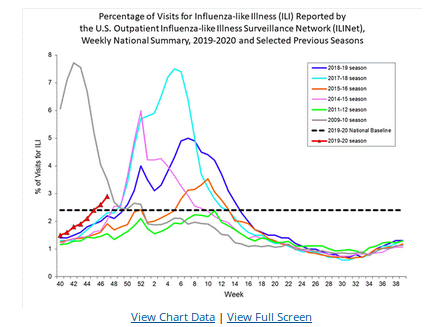#14,555
Ten days ago, in CDC FluView Week 46: ILI Has Now Exceeded National Baseline, we saw evidence of an early start to the 2019-2020 flu season. Today, delayed a few days by the Thanksgiving holiday, the CDC has released their Epi Week 47 FluView report, and it finds flu continues to increase across the nation.
While the heaviest activity continues in the deep south, northern states are beginning to report moderate activity as well.B/Victoria viruses are leading the pack, although that could shift to either A/H1N1 or A/H3N2 as the season progresses. For now, children under the age of 4 appear most affected, followed by those over the age of 65 (see hospitalization chart below).
The percentage of doctors office visits attributed to ILI (influenza like illness) has been at, or above, the national baseline for 3 weeks. The chart below shows the early start, and trajectory, of ILI reports across the country.
The Key points from today's FluView are:
It is too early to know what kind of flu season we will see in North America, as much will depend upon what subtype becomes dominant this winter. Influenza B typically hits kids hardest, H3N2 is often hardest on those over 65, while H1N1 tends to impact younger adults.
While an early start may mean an earlier end to the flu season, it isn't guaranteed. Last year we saw one of the longest flu seasons (21 weeks) in recent memory, and alhtough it started out fairly mild, by mid-January it morphed into a moderately severe epidemic.
It is not too late to get a flu shot, and if you do get sick, call your doctor. Early treatment with antivirals can shorten your illness, and for some patients, can be life saving.Now is also the time to rigorously practice good flu hygiene. Stay home if you are sick, avoid crowds, wash your hands frequently, and cover your coughs and sneezes.
If flu does visit your household this winter, the CDC has a 21 page (PDF) Home Flu Treatment Guide, which covers everything from knowing the symptoms of flu, to setting up (and cleaning) a sick room, to when it is time to seek medical help.
 |
| PDF FILE |
(EXCERPT)
Know the emergency warning signs
There are “emergency warning signs” that should signal anyone to seek medical care urgently. Seek care if the sick person has ANY of the signs below.
In children, emergency warning signs that need urgent medical attention include:
• Fast breathing or trouble breathingIn addition to the signs above, get medical help right away for any infant who has any of these signs:
• Bluish skin color
• Not drinking enough fluids
• Not waking up or not interacting
• Being so irritable that the child does not want to
be held
• Flu-like symptoms improve but then return with
fever and worse cough
• Fever with a rash
• Being unable to eat
• Has trouble breathing
• Has no tears when crying
• Significantly fewer wet diapers than normal
In adults, emergency warning signs that need urgent medical attention include:
• Difficulty breathing or shortness of breath
• Pain or pressure in the chest or abdomen
• Sudden dizziness
• Confusion
• Severe or persistent vomiting
• Flu–like symptoms that improve but then return
with fever and worse cough
This is an excellent guide, and well worth downloading and printing out, or keeping as a reference PDF on your phone/tablet/computer.




